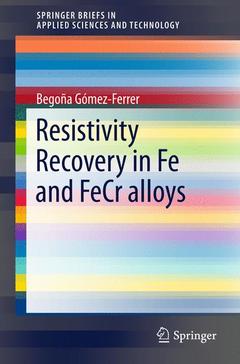Description
Resistivity Recovery in Fe and FeCr alloys, 1st ed. 2016
SpringerBriefs in Applied Sciences and Technology Series
Author: Gómez-Ferrer Begoña
Language: English
Approximative price 52.74 €
In Print (Delivery period: 15 days).
Add to cartSupport: Print on demand
Description
/li>Contents
/li>Biography
/li>Comment
/li>
This book covers the Resistivity Recovery (RR) technique, underlying its physical principles, performance and problematic. A concise review on the state of the art is provided, showing the advances in radiation modelling, linking both experimental and theoretical fields. The reader will find a data compilation and comparison of up-to-date results obtained from the European Fusion Development Agreement model alloys.
Chapter 1. Thermonuclear Fusion
1.1. The green solution
1.2. Materials problem in fusion reactors
1.3. Modelling and experimental validation
1.4. Interest of Fe-Cr alloys
Chapter 2. Resistivity and experimental techniques
2.1. Resistivity Basics2.1.1. Electronic Band structures
2.1.2. Quantum Drude model
2.1.3. Matthiessen’s rule
2.1.4. SRO effects
2.1.5. Non-simple metals: the s-p interaction
2.1.6. Magnetic effects and deviations from Matthiessen’s rule: the two current model
2.2. Radiation effects on resistivity
2.3. Annealing theory
2.3.1. Defect diffusion
2.3.2. Rate theory
2.4. Resistivity recovery method
2.5. Improved RR Method
Chapter 3. Experimental on Resistivity
3.1. Four-point probe method: VdP technique
3.2. Low-voltage measurement technique: Delta Method
3.3. System requirements
3.4. Sample preparation
3.5. Set-up
<3.6. Resistivity and temperature measurements
Chapter 4. State of the art
4.1. Accepted picture in pure Fe
4.2. Critical review of pure Fe accepted picture
4.3. The effect of Cr
4.4. The contribution of modelling
Chapter 5. Resistivity recovery on Fe and on Fe-Cr alloys
5.1. Defect production by 5 MeV H+
5.2. Fe-Cr residual resistivity characterization
5.3. Irradiation runs: effects of CCr
5.4. RR result in pure Fe
5.5. RR results in Fe-Cr
5.5.1. The effect of CCr in classical RR results
5.5.2. The effect of improved RR method
5.5.3. Final discussion
5.5.4. Comparisons with the literature
Chapter 6. Outlook
Begoña Gómez-Ferrer is currently a post-doc researcher at the Fusion Technology Division of the National Fusion Laboratory CIEMAT in Madrid, Spain. Her research interests include the study of dielectric and optical properties of specific insulators, fibres optics and windows for future fusion reactors.
Emphasizes the Resistivity Recovery technique, from theory to applications
Underlines the physical principles and state of the art on experiments and modelling on resistivity recovery
Proposes improvements to the classical resistivity recovery method
Includes supplementary material: sn.pub/extras




